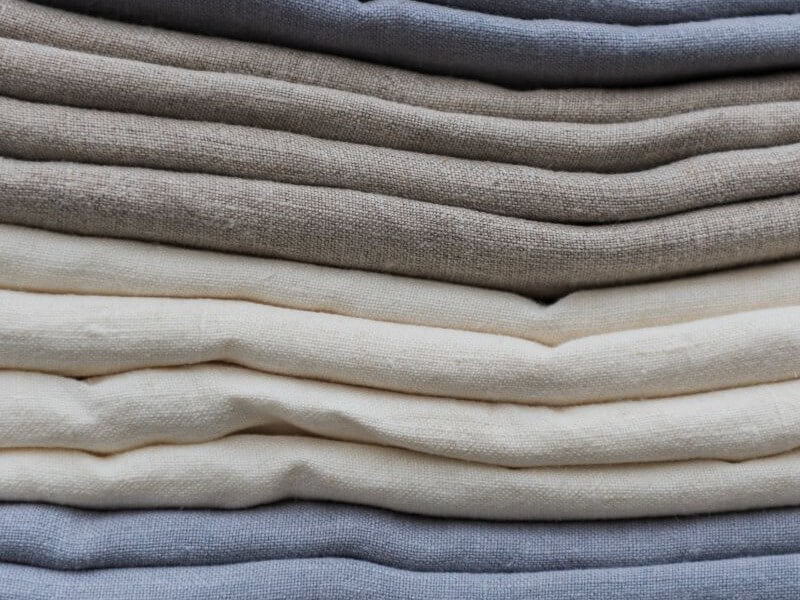
Linen fabric vs. hemp fabric
Share
Linen fabric vs. hemp fabric - what are the differences between the two? In this blog I'll go through similarities and differences between hemp fabric and linen fabric.
Hemp is a less familiar material than linen fabric to most people. I often get many kind of questions about hemp. How does it feel like? What qualities does hemp have? How is it compared to linen fabric? Is hemp more ecological than linen?
Linen fabric vs. hemp fabric - a wide comparison
Both linen and hemp are stalk fibres comprising of cellulose. Both are natural materials, stalk plants, which have been cultivated for thousands of years around the world.
Hemp fabric looks and feels much like linen fabric, but is even more ecological.
In addition, according to our customers hemp fabric is even softer, more breathable than linen fabric.
Here I'll go through more in-depth the different properties of hemp and linen fabrics.
Feel
The hemp fabric we use feels very similar to firm, high-quality linen fabric. It feels very soft, similar to stonewashed linen or linen softened in use.
Hemp fabric is very well breathable, absorbent and dries fast. These properties make hemp bed linen feel very fresh in hot, humid weather. On the other hand, they make hemp fabric well suitable for hemp towels.
During cold winter nights hemp feels like a warming hug around you.
Linen fabric is often described with the same words. Even so, I often get feedback from my customers how hemp bed linen are even lovelier than linen sheets.
Look
Hemp fabric wrinkles similarly to linen fabric. Based on the feedback I've got I'd say hemp fabric is a little less wrinkly than linen fabric.
HEMPEA hemp fabric has a lively surface which is slightly uneven. On the other hand it has a slight silky shimmer.
Ecological aspects
Hemp is always described as a very ecological natural material. Linen fabric is also ecological. Here I'll go through more in detail the ecological aspects of both materials.
Water consumption
Both hemp and linen grow well without irrigation, so they do not use up sweet water other than rain.
Both plants require water in handling of the fibre. To produce linen fabric an average of 3800 liters of water per one kilo of fabric material is needed. The same number for hemp fabric is an average of 2700 L/kg.
From this around 75% is rain water needed for the plant to grow.
This means to produce linen fabric requires about 30% more water than hemp fabric. For comparison: cotton production takes at least 3-4 times more water than hemp fabric production. (1)
Fertilizers and pesticides
Both hemp and linen fiber are modest natural fibers, that need relatively little fertilizers to grow.
The biggest difference between the plants is sesitivity to weeds.
Hemp grows fast, it has wide roots and a large plant. The fast growth of hemp stops efficiently weeds from growing.
Weeds easily affect the growth of flax linen. The weeds easily also effect harvesting of linen.
(2) (3)
Crops
Based on literature and research linen and hemp are suprisingly similar in crop amounts per area farmed.
Because of many affecting things such as the soil, climate and weather,t here are varying information available.
Even so, approximately 4000-8000 kg/ha hemp raw fiber can be achieved. In good conditions even 7000-15000 kg/ha is possible.
For linen the raw fiber yield is around 3000-8000 kg/ha.
Usually the harvested raw fibre results in 15-20% in fiber used for the fabric.
(3) (4)
Carbon dioxide binding
Hemp grows very fast and therefore binds a lot of carbon dioxide in its roots and plant.
Growing hemp binds around 13500 kg of CO2 per hectare of area cultivated. On top of that, the leaves and roots bind around 500 kg of CO2 per hectare.
Linen cultivation binds around 3700 kg of CO2/ha.
This means hemp is truly a carbon sink! And this is an important property now that we are fighting against carbon dioxide emissions and global warming.
(3) (5)
The soil
Growing hemp has many positive effects on the soil.
With its wide roots hemp prevents effectively erosion. Hemp plant also binds heavy metals and other toxic substances from the soil. A lush hemp growth stops weeds from growing and prevents their growth long term (6)
Both hemp and linen cultivation are well suitable for crop rotation. Crop rotation improves nutritions in the soil and the soil composition.
Durability
The fibre for hemp fabric is derived from the long stem of the plant. The long hemp fibre is said to be one of the most strongest plant fibres. The strong hemp fibre has been used for example for ropes and sails.
Hemp fibre is around 40% more durable than linen fibre (7).
In general there are many things affecting the durability of a fabric. In addition to the fibre used for example the width of the thread, the way the fabric is weaved and died as well as different softening procedures affect the durability of a fabric.
The softening of the hemp fabric is done with hot water steam. The softening makes our fabric soft as a feather, and perfectly suitable for bed linen. But at the same time it decreases durability.
Our hemp fabric is made in Romania with traditional methods where the fiber is handled and softened mechanically with water as help.
In other words, although hemp fibre is naturally more durable than linen, both linen fabric and hemp fabric can be very durable. High-quality hemp fabric has an excellent durability.
Price
Hemp is a humble plant with good crops, so it can be surprising twhy hemp bed linen is usually much more valuable than linen bed linen.
The world wide hemp production is still very small compared to linen. Often hemp fabric producers don't have highly sophisticated, automated and latest technology in use. This applies also for our fabric producer.
Hemp fabric can be up to two times the price of linen which of course affects the prices of the products.
Our HEMPEA products are made in Finland which also affects the end prices.
Which is better: linen fabric or hemp fabric?
As you could read, hemp and linen fabrics have many similarities. Both are good options in terms of feel and ecofriendliness.
Our favorite is hemp, of course. It just feels perfectly gentle and loving on your skin. On top of that, hemp can be considered even more ecofriendly than linen.
Get to know hemp fabric
Do you already know and use linen fabric? Would you like to try hemp fabric?
You can easily to by ordering our hemp fabric sample set.
References
1) Averink (2015) Global water footprint of industrial hemp textile. http://essay.utwente.nl/68219/.
2) https://www.richters.com/show.cgi?page=InfoSheets/d2701.html .
Referred on 19.1.2023
3) https://ita-suomi.proagria.fi/sites/default/files/attachment/tietokortti_monipuolinen_kuituhamppu_0.pdf . Referred on 19.1.2023
4) https://www.farmit.net/kasvinviljely/kasvuohjelma/erikoiskasvit/kuitupellava .
Referred on 19.1.2023
5) http://news.europeanflax.com/en/lin/linen-eco-system/ . Referred on 19.1.2023
6) Zimniewska (2022) Hemp fibre properties and processing target textile: a review. Materials. https://doi.org/10.3390/ma15051901
7) Kumpikaite et al. (2021) Comparison of Mechanical and End-Use Properties of Grey and Dyed Cellulose and Cellulose/Protein Woven Fabrics. Materials (Basel). https://doi.org/10.3390/ma14112860.
